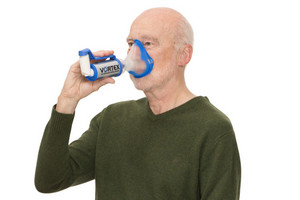
COPD stands for “chronic obstructive pulmonary disease”. As the name suggests, people with COPD often have narrowed bronchial tubes which may also be coated in mucus. Pulmonary emphysema can also occur, which destroys the alveoli. Typical COPD symptoms are shortness of breath on exertion, chronic cough, sputum and restricted physical performance.
For this reason it is important to provide comprehensive treatment and care of the airways in patients with COPD. An effective option to achieve this is inhalation. We have compiled the FAQs and answers to any questions you may have concerning “inhalation for COPD”.

People with COPD depend on comprehensive airway treatment and care. Unlike asthma, the narrowing (obstruction) of the airways in COPD is not completely reversible, but is progressive. This means that the bronchial tubes cannot completely recover.
It is therefore especially important that disease progression and symptoms are managed as well as possible in patients with COPD. For this reason, medications have to be able to efficiently reach the bronchial tubes and the lungs.
Physical training also has an important role to play in the treatment of COPD. This is because sport is one of the most efficient ways to improve quality of life and breathlessness in many chronic respiratory diseases. Respiratory therapy is also an important supportive treatment for COPD.
Drugs for the treatment of COPD are generally administered by inhalation, a tried and tested method to treat respiratory problems and diseases. It is the most direct delivery method, as when used correctly, the active substances reach the lungs directly. In patients with COPD, inhalation therapy also helps treat and soothe the damaged airways – from the bronchial tubes to the alveoli.

There is a wide range of inhalation devices that can be used for the treatment of COPD, so the individual needs of patients can be addressed. In COPD, the inhalation therapy with a nebuliser, such as the PARI BOY or the PARI COMPACT2 provides invaluable and specific support. Here, especially fine droplets are formed which can be inhaled into the lungs with normal resting respiration.
Metered-dose aerosols and powder inhalation can also be used alongside moist inhalation with a nebuliser in patients with COPD. With metered-dose aerosols, the active substance is in a pressurised container along with a propellant and is released as a puff and inhaled. With powder inhalers, the active substance is provided as a powder without any additional propellant and is also inhaled.
The inhalation therapy consists of three elements: Medication, inhalation system and patient. COPD patients must be able to correctly use the inhalation system. People who have coordination or breathing problems often also have problems using standard inhalation systems such as powder inhalers or metered-dose aerosols.
These patients should therefore use nebulisers for inhalation or a holding chamber for metered-dose aerosols. Normal resting respiration is fine for nebuliser inhalation. In contrast, inhaling with a metered-dose aerosol requires coordinated and concentrated inhalation. This is achieved by using a holding chamber. The VORTEX® holding chamber also allows one-handed operation, so it can still be used in patients with reduced strength in their fingers or with joint pain.
Firstly, saline solutions can be inhaled when treating COPD. This is because they liquify the mucus in the airways in patients with acute infections associated with increased mucus production. This makes it easier to cough up the mucus. Secondly, drugs designed to dilate the airways or to fight infections can be inhaled.

As already described above, people with COPD can and should inhale COPD medications. This is because inhalation delivers the active ingredient directly to where it is needed: in the lungs or the bronchial system. This reduces potential side effects and less medication is needed for the desired effect – compared to taking a tablet.
Patients with COPD firstly take medications such as antibiotics to fight off bacterial infections, which can otherwise lead to a sudden progression of the disease, also referred to as exacerbations. This is why it is important to fight infections as effectively as possible. Inhalation with mucolytics (medications that make mucus less thick and sticky) can help release the secretions, making them easier to cough up.
Secondly, drugs are used that dilate the bronchial tubes and so provide the best option for counteracting the obstruction. We distinguish between short-acting and long-acting bronchodilators (drugs that dilate the airways). The difference is that the long-acting medications only start to work a certain amount of time after inhalation, and that their effect lasts for longer. They are used for standard therapy. With short-acting bronchodilators, the effect is immediate. They are used for acute attacks and breathlessness.
NB: The attending doctor will decide which medications the patient should take, and will prescribe these accordingly.
Inhalation with saline solution can help patients with COPD avoid acute infections if carried out once or twice a day. Inhaling more often can help treat acute infections. The slower-acting medications should also be inhaled once a day to ensure long-term success of the therapy. It is important that patients stick to their prescribed medication therapy.

To ensure treatment success, it is important that the inhalation system is used properly. Incorrect use can mean that too little of the active substance reaches the lungs, so it cannot work properly. Certain medications, if they end up in the throat instead of the bronchial tubes, can also cause undesirable side effects.
To avoid this it is firstly important that patients are properly coached and know how to use the devices properly. And secondly, as mentioned above, there are holding chambers that can be used for metered-dose aerosols whose use demands a certain level of coordination. These “spacers” make the COPD spray easier to use.
Note: The information in this blog post is not a treatment recommendation. The needs of patients vary greatly from person to person. The treatment approaches presented should be viewed only as examples. PARI recommends that patients always consult with their physician or physiotherapist first.
An article written by the PARI BLOG editorial team.
© 2025 PARI GmbH Spezialisten für effektive Inhalation